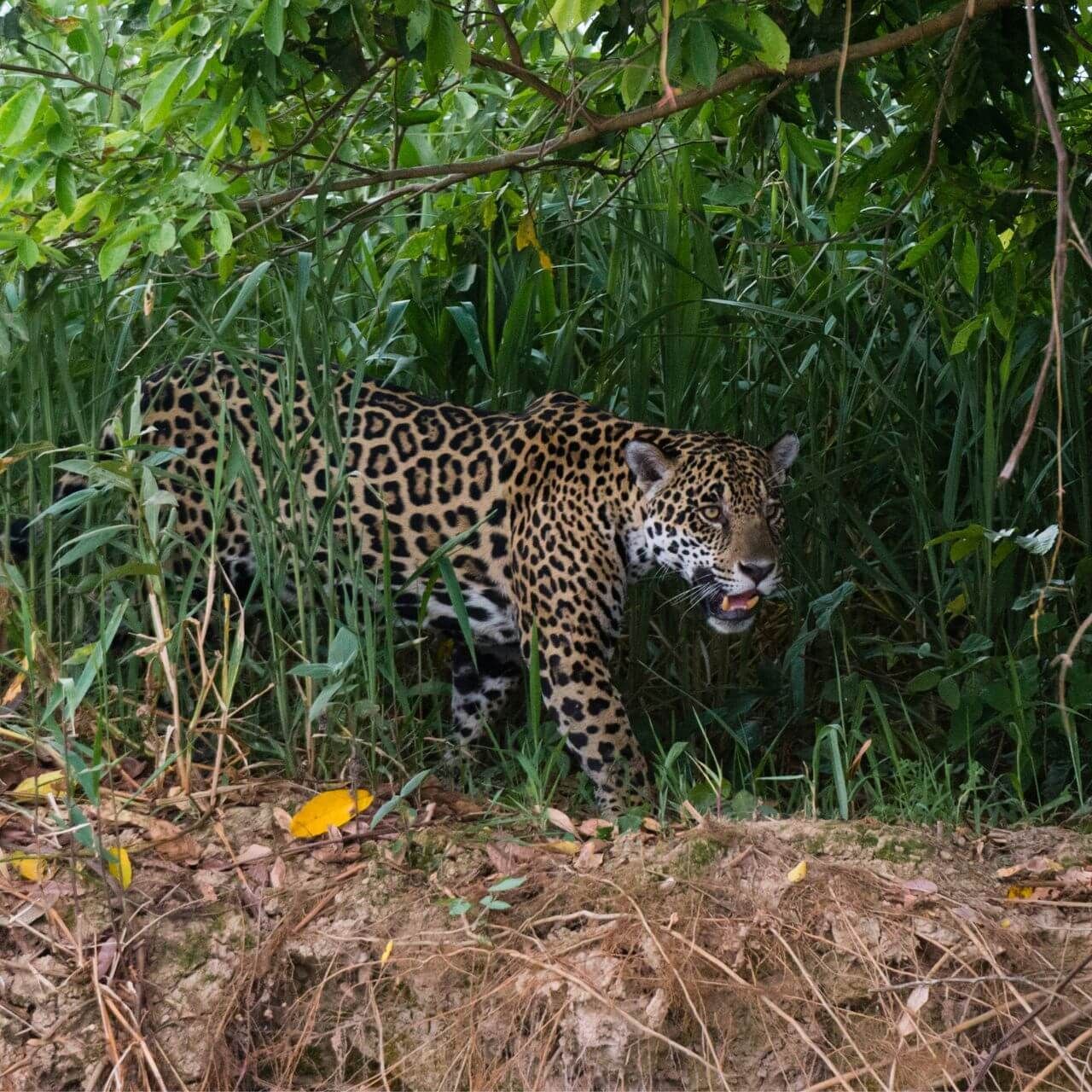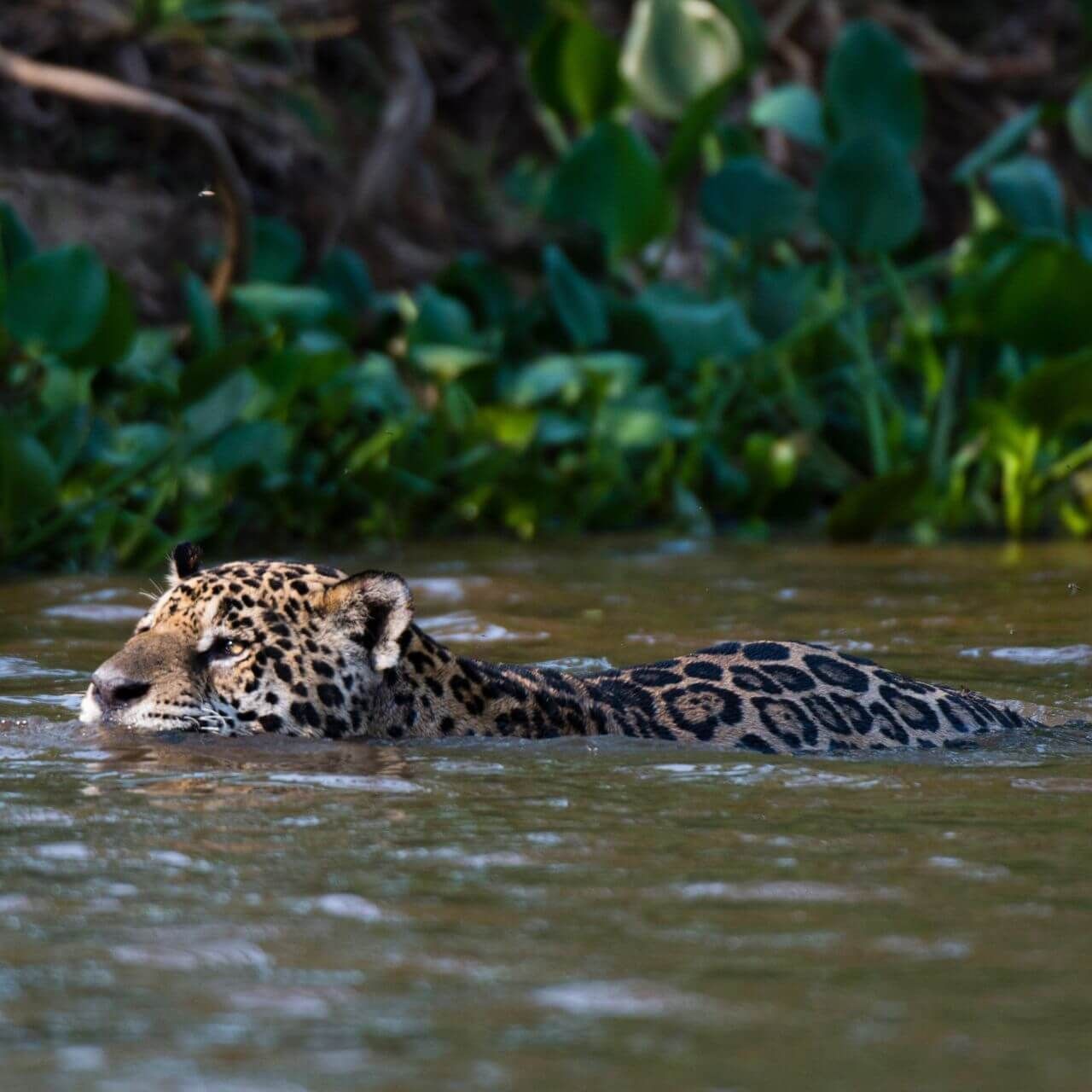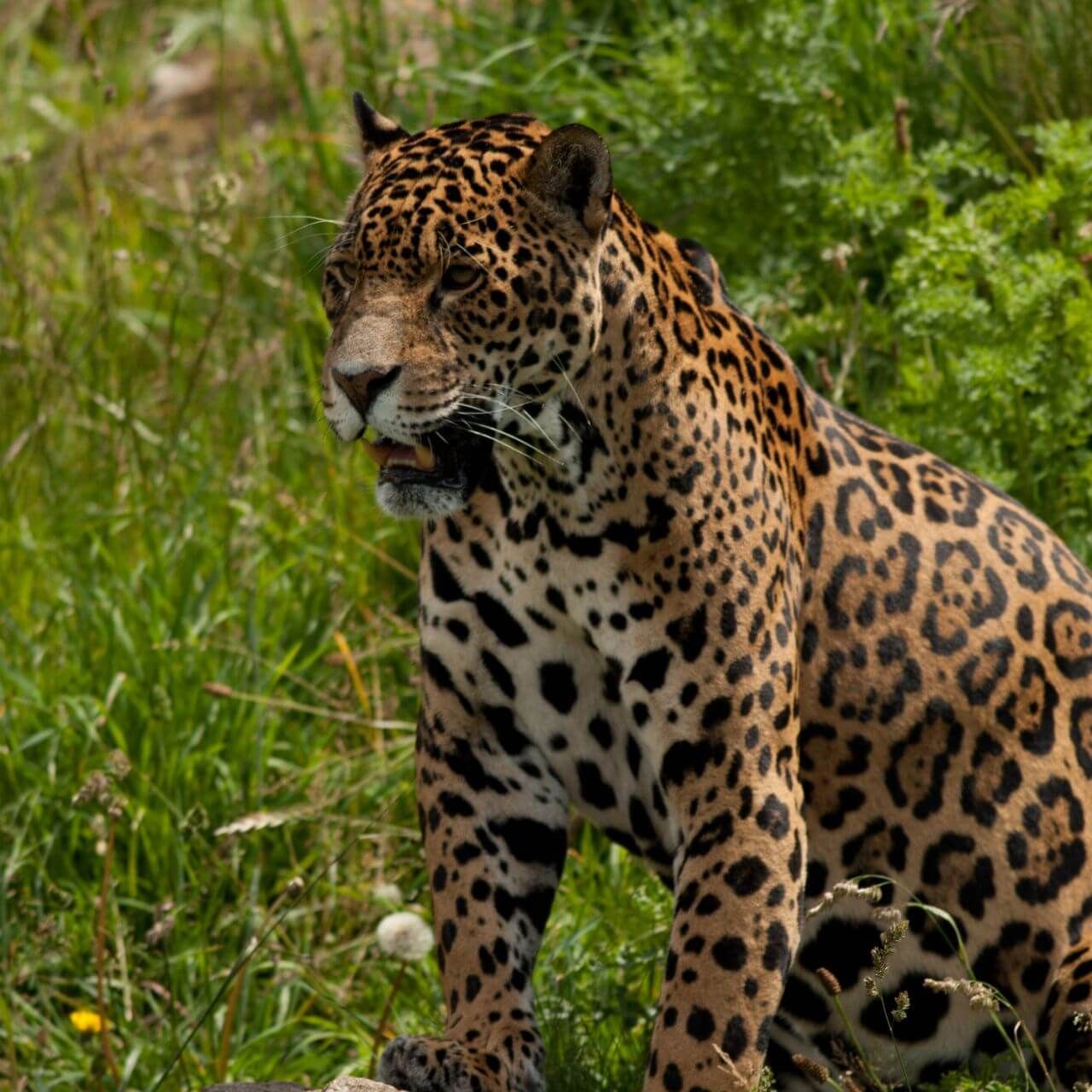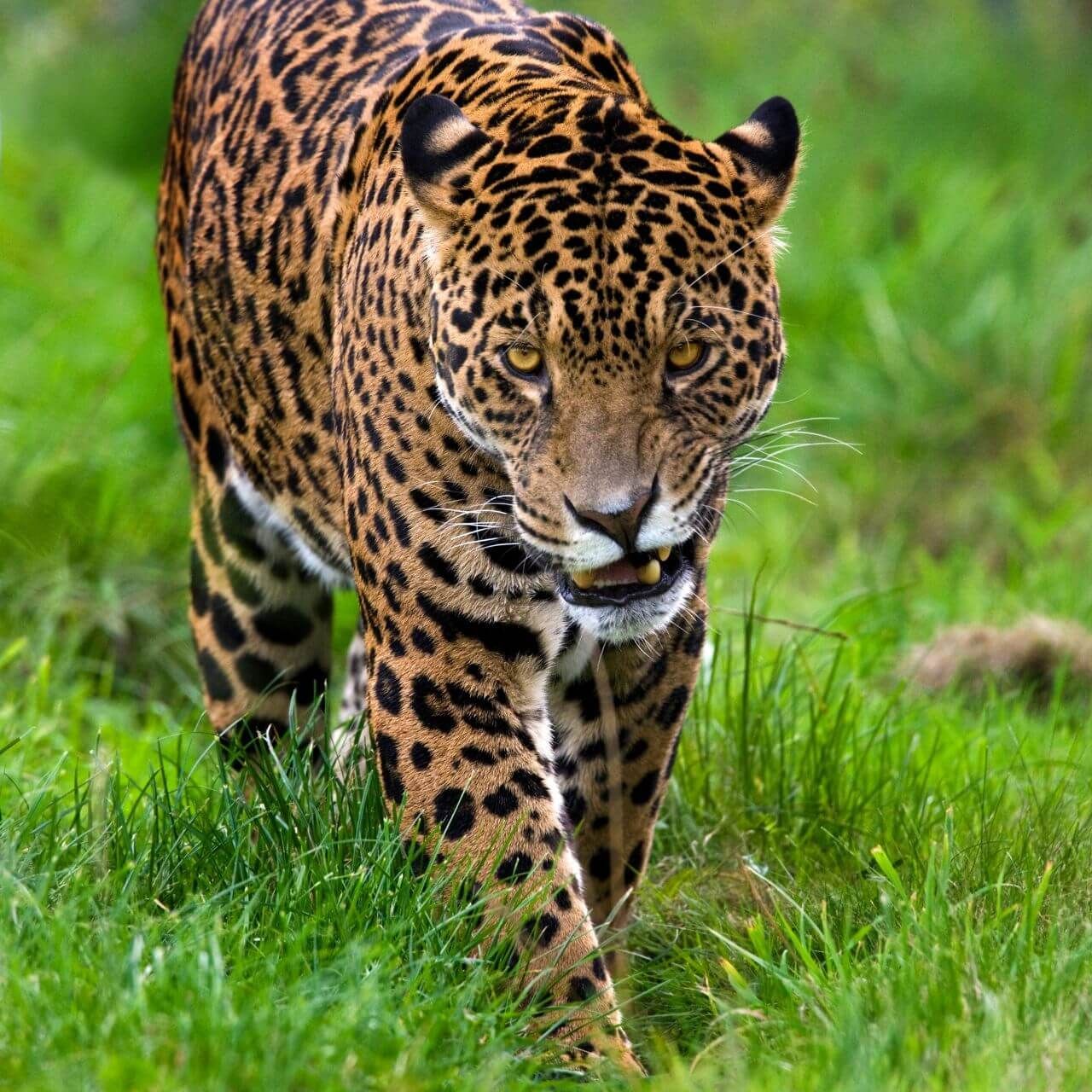Jaguars

Let's Learn About Jaguars
Word of the Week
Apex Predator
An apex predator is the top predator in its environment. It is at the top of the food chain with no natural predators of its own.
Jaguars, tigers, and polar bears are all apex predators.
Fast Facts

Where do jaguars live?
Most jaguars are found in South America. Some live in the southern part of North America.
Jaguars live in habitats like rainforests, especially the Amazon Rainforest. They also live in grasslands, wetlands, and other ecosystems where prey is available.
What do jaguars eat?
Jaguars are carnivores.
They are powerful predators with sharp teeth and a strong bite force. Jaguars eat over 80 species, including capybaras, giant anteaters, caimans, and turtles.


What traits do jaguars have?
Jaguars are a species of big cat known for their...
- Orange and black coat.
- Large size.
- Impressive hunting ability.
- Ability to swim and hunt in water.
How many jaguars are there?
Jaguars are listed by the IUCN as near threatened, though scientists do not know exactly how many remain.
Jaguars face threats such as deforestation, human-wildlife conflict, and poaching for their fur and other trophies.

Species Spotlight
Jaguars Vs. Leopards
Jaguars and leopards are closely related. Therefore, they have many traits in common. They are both powerful carnivores with sharp teeth and claws. They are both orange with black rosettes. They are both solitary big cats. It can be hard to tell them apart because of their similarities.
However, while these two big cats have a lot in common, several traits make them different.
Range:
Jaguars live in South America and the southern part of North America. Leopards live in Africa and Asia.
Habitat:
Jaguars live in rainforests, wetlands, and grasslands. Some leopards, like the African leopard, live in warm savannas. Other leopards, like the Amur leopard, live in cold, snowy forests.
Size:
Jaguars are larger than leopards. They have wider bodies and thicker heads, while leopards tend to be thinner.
Pattern:
Jaguar rosettes are larger and often have a polka dot in the center. Leopard rosettes are smaller and do not have a polka dot in the center.
The next time you see an orange, rosette-covered cat, use these differences to determine if it is a jaguar or a leopard.
BRAIN BLAST
What other cats have a similar pattern to jaguars and leopards? What differences can you use to tell them all apart?
Conservation Corner
Black Panthers in Zoos
Black panthers are fierce and mysterious. They are some of the most popular animals in zoos. However, black panthers aren’t a true species of animals. The term “black panther” describes two species, jaguars and leopards, when they have all-black fur. To understand why some jaguars and leopards have black fur, we must learn about melanin.
Melanin is a dark pigment (think of pigment like color, paint has many pigments). It is the pigment that gives our skin and hair its color. If you have dark skin or hair, it has high amounts of melanin. If you have light skin or hair, it has a small amount of melanin.
Animals, including people, inherit traits like skin and hair color from our parents. However, sometimes a change, called a mutation, causes an animal’s offspring to look different.
Melanism is a mutation that causes animals to produce high amounts of melanin. They often produce so much melanin that they appear completely black. So, a black panther is a melanistic jaguar or leopard!
Melanism is very rare in the wild but common in zoos. In zoos, melanistic jaguars and leopards are bred in hopes that their cubs will also be melanistic. However, this causes many problems. The adults breed frequently, which causes health problems for the females. The offspring may also have health problems if their parents are too closely related.
We can support and protect black panthers by supporting zoos that breed animals responsibly. If a zoo near you has black panthers, ask where they came from and if they are used for breeding on your next visit!
Jaguar & Leopard Mix-Up
Compare and contrast jaguars and leopards.
Jaguar Challenge
Mastering the Differences Between Jaguars & Leopards
Beginner
Using the information we learned about jaguars and leopards, circle their similarities in green and their differences in red.
On page 2, draw a jaguar and leopard. Make sure to include their differences in your drawings.
Expert
Read the prompt on page 1 to investigate jaguars and leopards further. Highlight their similarities in green and their differences in yellow.
On page 2, draw both species.
On page 3, complete the Venn diagram to emphasize their similarities and differences.
Finally, complete the short-answer questions on page 4.
Learn More!
*Please note: This video shows a jaguar catching a peccary*
Glossary
Adaptation
The process by which a species becomes more fit for its environment over the course of several generations. It is a result of natural selection.
Ambush
Sneak attack.
Apex Predator
The animal at the top of its food chain; it has no natural predators.
Black Panther
A melanistic (all-black) jaguar or leopard.
Camouflage
The ability for an organism to blend into its surroundings usually to hide from prey or predators.
Carnivore
An animal that eats other animals.
Deforestation
The act of forests being cut down or burned to create room for human expansion.
Endangered
Referring to an organism that is threatened with extinction.
Habitat
The type of environment where a plant or animal lives.
Habitat Loss
When habitats are destroyed and changed into human-managed land such as farms or cities.
Human-Wildlife Conflict
Occurs when humans and wildlife live in close proximity and negatively impact each other.
Keystone Species
A species whose presence has an unusually high impact on the ecosystem relative to its population size. Without them, the environment would collapse.
Melanin
The dark pigment that gives hair and skin its color.
Melanistic
A mutation resulting in an animal producing so much melanin that they appear all-black.
Mutation
A change in an organism's DNA.
Poaching
The illegal act of hunting or capturing an animal.
Predator
An animal that hunts other animals for food.
Prey
An animal that is hunted and eaten by another animal.
Range
The geographic location where an animal lives.
Rosette
A hollow circle or rose-shaped marking on animals like jaguars and leopards.
Species
A closely related group of animals with similar characteristics that are capable of reproducing (example: tigers).
Territorial
Referring to an animal that defends an area (its territory) from other members of its species.
Sign Up for our Newsletter
Stay up to date with new adventures, live classes, deals, and more!

Helpful Resources
*Please note we do not offer refunds for EdZOOcating Adventures memberships. We recommend you explore the 3-day free trial prior to subscribing!*




